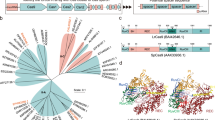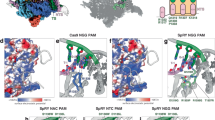Abstract
The rapid development of the CRISPR–Cas9, –Cas12a and –Cas12b genome editing systems has greatly fuelled basic and translational plant research1,2,3,4,5,6. DNA targeting by these Cas nucleases is restricted by their preferred protospacer adjacent motifs (PAMs). The PAM requirement for the most popular Streptococcus pyogenes Cas9 (SpCas9) is NGG (N = A, T, C, G)7, limiting its targeting scope to GC-rich regions. Here, we demonstrate genome editing at relaxed PAM sites in rice (a monocot) and the Dahurian larch (a coniferous tree), using an engineered SpRY Cas9 variant8. Highly efficient targeted mutagenesis can be readily achieved by SpRY at relaxed PAM sites in the Dahurian larch protoplasts and in rice transgenic lines through non-homologous end joining (NHEJ). Furthermore, an SpRY-based cytosine base editor was developed and demonstrated by directed evolution of new herbicide resistant OsALS alleles in rice. Similarly, a highly active SpRY adenine base editor was developed based on ABE8e (ref. 9) and SpRY-ABE8e was able to target relaxed PAM sites in rice plants, achieving up to 79% editing efficiency with high product purity. Thus, the SpRY toolbox breaks a PAM restriction barrier in plant genome engineering by enabling DNA editing in a PAM-less fashion. Evidence was also provided for secondary off-target effects by de novo generated single guide RNAs (sgRNAs) due to SpRY-mediated transfer DNA self-editing, which calls for more sophisticated programmes for designing highly specific sgRNAs when implementing the SpRY genome editing toolbox.
This is a preview of subscription content, access via your institution
Access options
Access Nature and 54 other Nature Portfolio journals
Get Nature+, our best-value online-access subscription
$32.99 / 30 days
cancel any time
Subscribe to this journal
Receive 12 digital issues and online access to articles
$119.00 per year
only $9.92 per issue
Buy this article
- Purchase on SpringerLink
- Instant access to full article PDF
Prices may be subject to local taxes which are calculated during checkout




Similar content being viewed by others
Data availability
Regarding accession codes, the five Gateway-compatible Cas9 entry vectors are available from Addgene: pYPQ166-SpRY (no. 161520, zSpRY), pYPQ266E (no. 161521, SpRY-D01A-PmCDA1-UGI), pYPQ262m (no. 161522, wtTadA-TadA*-zSpCas9-D10A), pYPQ262-ABE8e (no. 161523, TadA8e-zSpCas9-D10A) and pYPQ262B-ABE8e (no. 161524, TadA8e-zSpRY-D10A). The high-throughput sequencing data sets have been submitted to the National Center for Biotechnology information database under Sequence Read Archive Bio Project ID PRJNA665932.
References
Zhang, Y., Malzahn, A. A., Sretenovic, S. & Qi, Y. The emerging and uncultivated potential of CRISPR technology in plant science. Nat. Plants 5, 778–794 (2019).
Tang, X. et al. A CRISPR–Cpf1 system for efficient genome editing and transcriptional repression in plants. Nat. Plants 3, 17018 (2017).
Ming, M. et al. CRISPR–Cas12b enables efficient plant genome engineering. Nat. Plants 6, 202–208 (2020).
Zhu, H., Li, C. & Gao, C. Applications of CRISPR–Cas in agriculture and plant biotechnology. Nat. Rev. Mol. Cell Biol. 21, 661–677 (2020).
Schindele, A., Dorn, A. & Puchta, H. CRISPR/Cas brings plant biology and breeding into the fast lane. Curr. Opin. Biotechnol. 61, 7–14 (2020).
Tang, X. et al. A large-scale whole-genome sequencing analysis reveals highly specific genome editing by both Cas9 and Cpf1 (Cas12a) nucleases in rice. Genome Biol. 19, 84 (2018).
Jinek, M. et al. A programmable dual-RNA-guided DNA endonuclease in adaptive bacterial immunity. Science 337, 816–821 (2012).
Walton, R. T., Christie, K. A., Whittaker, M. N. & Kleinstiver, B. P. Unconstrained genome targeting with near-PAMless engineered CRISPR–Cas9 variants. Science 368, 290–296 (2020).
Richter, M. F. et al. Phage-assisted evolution of an adenine base editor with improved Cas domain compatibility and activity. Nat. Biotechnol. 38, 883–891 (2020).
Steinert, J., Schiml, S., Fauser, F. & Puchta, H. Highly efficient heritable plant genome engineering using Cas9 orthologues from Streptococcus thermophilus and Staphylococcus aureus. Plant J. 84, 1295–1305 (2015).
Kaya, H., Mikami, M., Endo, A., Endo, M. & Toki, S. Highly specific targeted mutagenesis in plants using Staphylococcus aureus Cas9. Sci. Rep. 6, 26871 (2016).
Kleinstiver, B. P. et al. Engineered CRISPR–Cas9 nucleases with altered PAM specificities. Nature 523, 481–485 (2015).
Hu, X. et al. Expanding the range of CRISPR/Cas9 genome editing in rice. Mol. Plant 9, 943–945 (2016).
Endo, M. et al. Genome editing in plants by engineered CRISPR–Cas9 recognizing NG PAM. Nat. Plants 5, 14–17 (2019).
Hua, K., Tao, X., Han, P., Wang, R. & Zhu, J. K. Genome engineering in rice using Cas9 variants that recognize NG PAM sequences. Mol. Plant 12, 1003–1014 (2019).
Ren, B. et al. Cas9-NG greatly expands the targeting scope of the genome-editing toolkit by recognizing NG and other atypical PAMs in rice. Mol. Plant 12, 1015–1026 (2019).
Zhong, Z. Improving plant genome editing with high-fidelity xCas9 and non-canonical PAM-targeting Cas9-NG. Mol. Plant 12, 1027–1036 (2019).
Sretenovic, S. et al. Expanding plant genome editing scope by an engineered iSpyMacCas9 system targeting the A-rich PAM sequences. Plant Commun. https://doi.org/10.1016/j.xplc.2020.100101 (2020).
Jiang, W., Bikard, D., Cox, D., Zhang, F. & Marraffini, L. A. RNA-guided editing of bacterial genomes using CRISPR–Cas systems. Nat. Biotechnol. 31, 233–239 (2013).
Zhong, Z. et al. Plant genome editing using FnCpf1 and LbCpf1 nucleases at redefined and altered PAM sites. Mol. Plant 11, 999–1002 (2018).
Zhou, J. et al. CRISPR–Cas9 based genome editing reveals new insights into microRNA function and regulation in rice. Front. Plant Sci. 8, 1598 (2017).
Rodriguez-Leal, D., Lemmon, Z. H., Man, J., Bartlett, M. E. & Lippman, Z. B. Engineering quantitative trait variation for crop improvement by genome editing. Cell 171, 470–480 (2017).
Hu, J. H. et al. Evolved Cas9 variants with broad PAM compatibility and high DNA specificity. Nature 556, 57–63 (2018).
Bae, S., Park, J. & Kim, J. S. Cas-OFFinder: a fast and versatile algorithm that searches for potential off-target sites of Cas9 RNA-guided endonucleases. Bioinformatics 30, 1473–1475 (2014).
Shimatani, Z. et al. Targeted base editing in rice and tomato using a CRISPR–Cas9 cytidine deaminase fusion. Nat. Biotechnol. 35, 441–443 (2017).
Tang, X. et al. Single transcript unit CRISPR 2.0 systems for robust Cas9 and Cas12a mediated plant genome editing. Plant Biotechnol. J. 17, 1431–1445 (2019).
Nishida, K. et al. Targeted nucleotide editing using hybrid prokaryotic and vertebrate adaptive immune systems. Science 353, aaf8729 (2016).
Kuang, Y. et al. Base-editing-mediated artificial evolution of OsALS1 in planta to develop novel herbicide-tolerant rice germplasms. Mol. Plant 13, 565–572 (2020).
Zhang, Y. & Qi, Y. CRISPR enables directed evolution in plants. Genome Biol. 20, 83 (2019).
Li, C. et al. Targeted, random mutagenesis of plant genes with dual cytosine and adenine base editors. Nat. Biotechnol. 38, 875–882 (2020).
Butt, H. et al. CRISPR-directed evolution of the spliceosome for resistance to splicing inhibitors. Genome Biol. 20, 73 (2019).
Lapinaite, A. et al. DNA capture by a CRISPR–Cas9-guided adenine base editor. Science 369, 566–571 (2020).
Koblan, L. W. et al. Improving cytidine and adenine base editors by expression optimization and ancestral reconstruction. Nat. Biotechnol. 36, 843–846 (2018).
Allen, F. et al. Predicting the mutations generated by repair of Cas9-induced double-strand breaks. Nat. Biotechnol. 37, 64–72 (2018).
Arbab, M. et al. Determinants of base editing outcomes from target library analysis and machine learning. Cell 182, 463–480 (2020).
Tang, X. et al. A single transcript CRISPR-Cas9 system for efficient genome editing in plants. Mol. Plant 9, 1088–1091 (2016).
Zhong, Z. et al. Intron-based single transcript unit CRISPR systems for plant genome editing. Rice 13, 8 (2020).
Ren, Q. et al. Bidirectional promoter-based CRISPR-Cas9 systems for plant genome editing. Front Plant Sci. 10, 1173 (2019).
Zhou, J. et al. Multiplex QTL editing of grain-related genes improves yield in elite rice varieties. Plant Cell Rep. 38, 475–485 (2019).
Wang, B. et al. Targeted mutagenesis of NAC transcription factor gene, OsNAC041, leading to salt sensitivity in rice. Rice Sci. 26, 98–108 (2019).
You, Q. et al. CRISPRMatch: an automatic calculation and visualization tool for high-throughput CRISPR genome-editing data analysis. Int. J. Biol. Sci. 14, 858–862 (2018).
Zheng, X. et al. Effective screen of CRISPR/Cas9-induced mutants in rice by single-strand conformation polymorphism. Plant Cell Rep. 35, 1545–1554 (2016).
Acknowledgements
This work was supported by the National Transgenic Major Project (award no. 2018ZX08020-003), the National Natural Science Foundation of China (award nos. 31771486, 32072045 and 31960423), the State Key Laboratory of Rice Biology (20200205) and the Science Strength Promotion Program of the University of Electronic Science and Technology of China (UESTC) to Yong Zhang and X.Z. This work was also supported by the National Science Foundation Plant Genome Research Program grants (award nos. IOS-1758745 and IOS-2029889), the US Department of Agriculture Biotechnology Risk Assessment Grant Program competitive grants (award nos. 2018-33522-28789 and 2020-33522-32274) and the Emergency Citrus Disease Research and Extension Program (award no. 2020-70029-33161) to Y.Q. S.S. is a Foundation for Food and Agriculture Research Fellow. Y.C. was supported by a scholarship from China Scholarship Council. The content of this publication is solely the responsibility of the authors and does not necessarily represent the official views of these funding agencies.
Author information
Authors and Affiliations
Contributions
Y.Q. and Yong Zhang designed the experiments. S.S., Q.R., S.L., Y.C., D.Y., C.P. and Yingxiao Zhang generated all the constructs. Q.R. and S.L. carried out rice protoplast transformation and data analysis. X.T. performed the data analysis. L.H. performed the Dahurian larch protoplast transformation and analysis. Q.R., S.L., Y.H., L.L. and Y.G. conducted rice stable transformation. Q.R. and S.L. analysed rice transgenic lines. L.L., Z.Z., G.L. and X.Z. helped with rice phenotype and genotype data analysis. W.L., L.Q. and C.L. collected the Dahurian larch material and developed the larch callus culture protocol. Y.Q., Yong Zhang, Q.R. and S.S. wrote the paper with input from other authors. All authors read and approved the final manuscript.
Corresponding authors
Ethics declarations
Competing interests
The authors declare no competing interests.
Additional information
Peer review information Nature Plants thanks Arjun Khakhar the other, anonymous, reviewer(s) for their contribution to the peer review of this work.
Publisher’s note Springer Nature remains neutral with regard to jurisdictional claims in published maps and institutional affiliations.
Supplementary information
Supplementary Information
Supplementary methods, figures and tables.
Rights and permissions
About this article
Cite this article
Ren, Q., Sretenovic, S., Liu, S. et al. PAM-less plant genome editing using a CRISPR–SpRY toolbox. Nat. Plants 7, 25–33 (2021). https://doi.org/10.1038/s41477-020-00827-4
Received:
Accepted:
Published:
Issue date:
DOI: https://doi.org/10.1038/s41477-020-00827-4
This article is cited by
-
Repairing a deleterious domestication variant in a floral regulator gene of tomato by base editing
Nature Genetics (2025)
-
Cryptic variation fuels plant phenotypic change through hierarchical epistasis
Nature (2025)
-
CRISPR–Cas applications in agriculture and plant research
Nature Reviews Molecular Cell Biology (2025)
-
Genome editing for trait optimization: the role of CRISPR, base editing and prime editing in modern era of plant science
Journal of Plant Biochemistry and Biotechnology (2025)
-
Precise fine-turning of GhTFL1 by base editing tools defines ideal cotton plant architecture
Genome Biology (2024)



